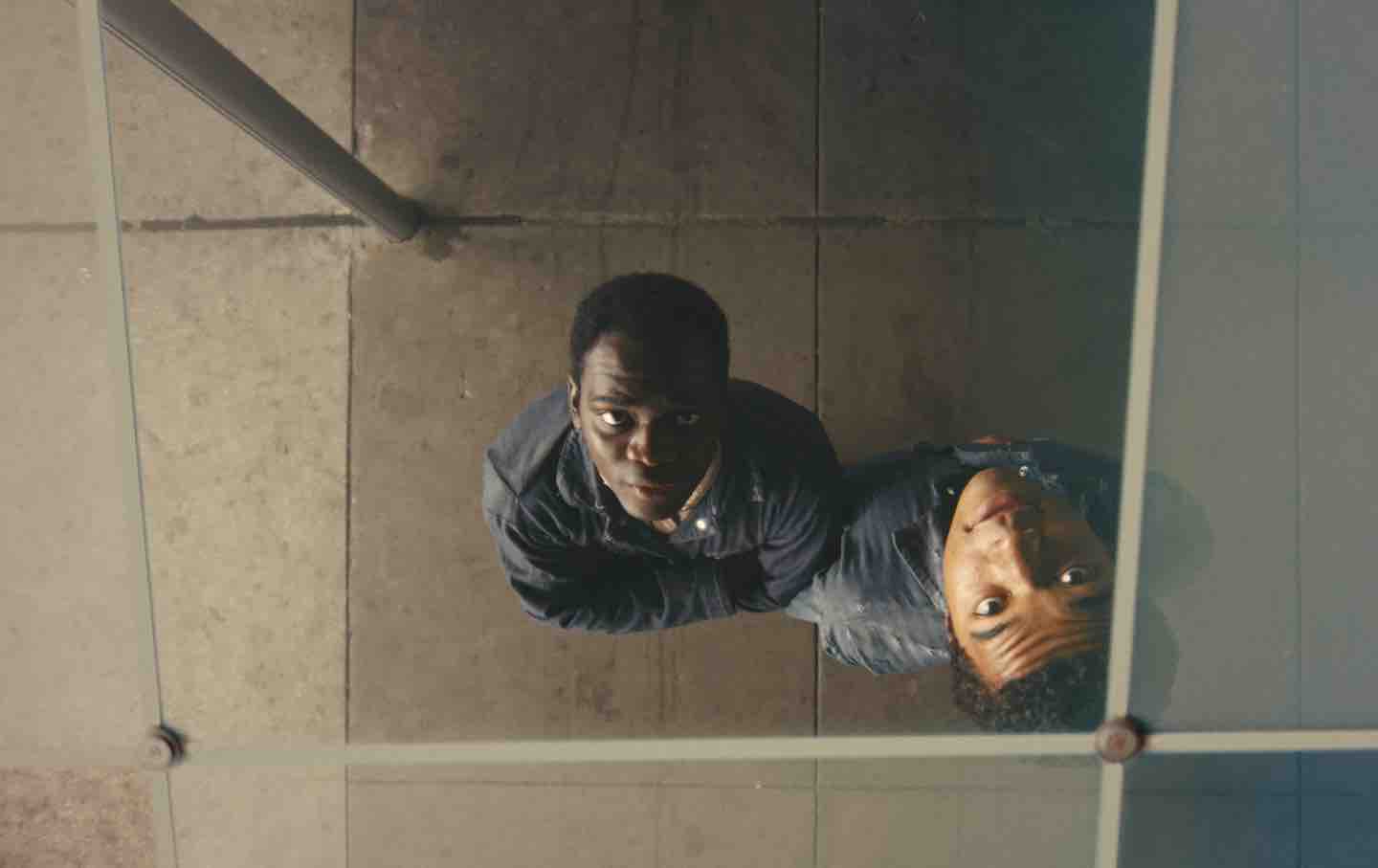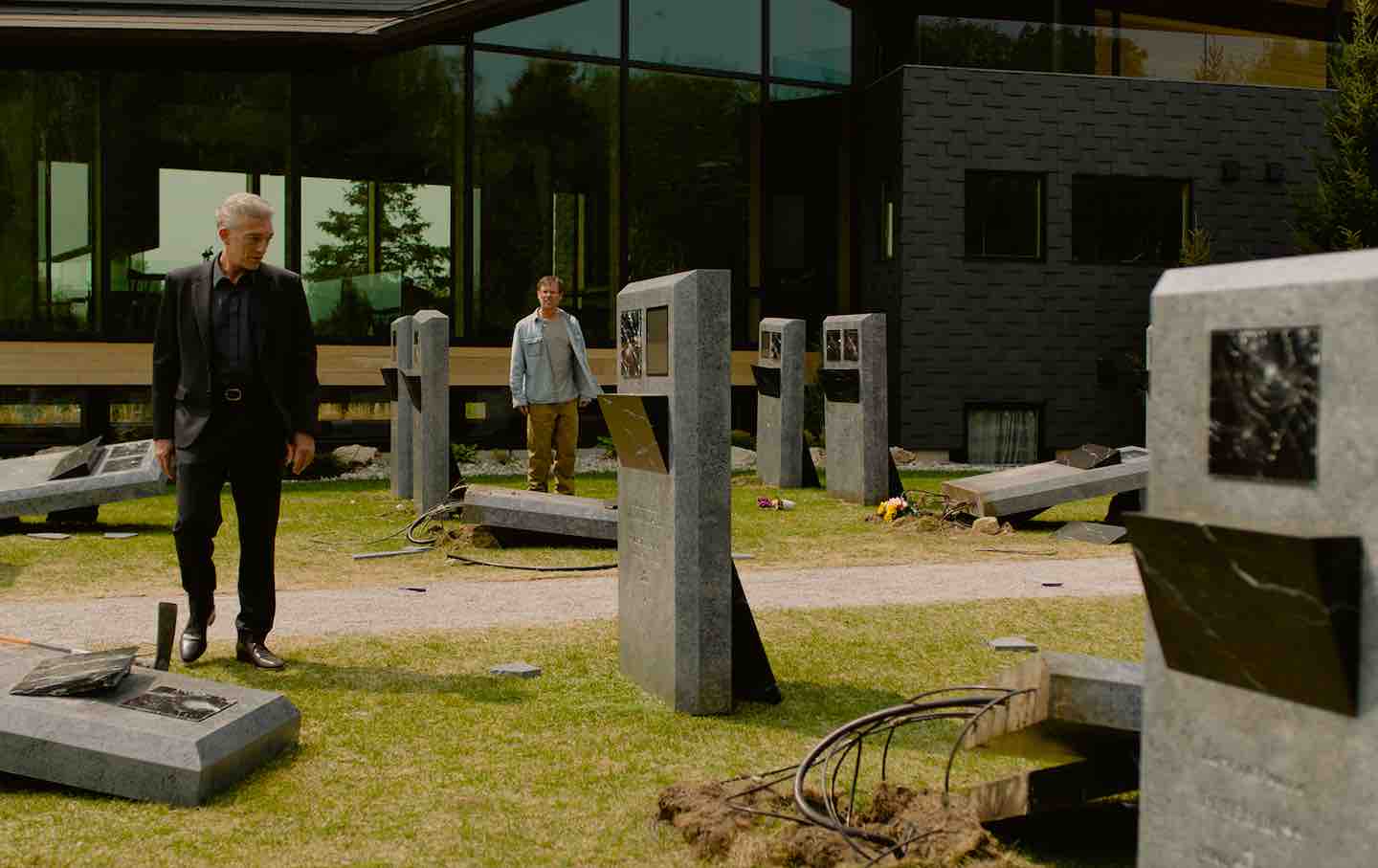The Illusory Beauty of Nickel Boys
The Illusory Beauty of “Nickel Boys”
An avant-garde adaptation of Colson Whitehead’s Pulitzer Prize–winning novel careens between questions of style and substance.

Nickel Academy, a reform school for troubled Florida boys, is not a place of learning—it’s a prison camp. The wards perform manual labor for no pay, can be killed if they try to flee, and receive vicious beatings from staff for minor infractions or no reason at all. Some absorb the malice of the institution, hardening into bullies. Others cozy up to power, finding tenuous security in obsequience. No one knows how many of the kids have died, or how many crimes the staffers have committed. But it’s the Black boys who get it the worst. Unlike their white peers, they are subject to the horrors of Jim Crow on top of the default debasement.
The academy is a living nightmare, but to subvert that ambient violence, Nickel Boys emphasizes play and tenderness. Directed by RaMell Ross and adapted from Colson Whitehead’s 2019 novel of the same name (sans “The”), the film is much less interested in its source text’s exploration of the civil rights movement. Ross instead zooms in on the precarious joys of Black boyhood, extracting wonder from tiny delights.
That departure is made explicit in the most fundamental way: how the camera is angled and what we are made to see. Nickel Boys is mostly composed of POV shots that either align with the sight lines of the characters or tightly follow their movements, like a GoPro. The choice yokes the world of the film to the characters’ purviews, forcing the viewer to inhabit their perspectives. While Whitehead economically re-created an entire social and historical epoch—turning the mid-century civil rights struggle into a bildungsroman—Ross dwells on the friendship at the center of the novel.
When it works, Ross’s style immerses the viewer in the story and shimmers with emotion. Gauzy images of nature and wildlife, intimate close-ups that magnify the faces of the characters, and archival footage from newsreels and other films swirl into lush reveries. It’s not a movie especially concerned with plot or the sweep of history. Period pieces tend to privilege verisimilitude and accuracy, turning the past into a live-action diorama. Nickel Boys has a more narrow focus, intensely concerned with the immediate world of its subjects. Nickel Academy may be hell, but Elwood (Ethan Herisse) and Turner (Brandon Wilson), the story’s heroes, brim with brio and curiosity. The film’s beautiful, perspectival imagery channels the irrepressible freedom of their young minds.
But who are these boys (and, later, men)? The contradiction of Ross’s approach is that these deep investments in subjectivity don’t actually yield much interiority. The POV shots, while stylish and arresting, work against the actors, limiting how they can use their bodies in a given scene. And the haphazard objects of those shots, as well as the accompanying archival B-roll, don’t often convey anyone’s thoughts or say much of note about the social dynamics of the Jim Crow South. The film’s insurgent beauty is distancing despite its distinct charms.
Nickel Academy is based on the infamous Dozier School. The real-life reformatory, initially named the Florida School for Boys, was a place of barbaric abuse and neglect from its opening in 1900 to its closure in 2011. “Boys went in damaged and came out destroyed,” summarized the Tampa Bay Times in one of its many reports on the bloody legacy of the school.
Whitehead’s novel, partly inspired by that reporting, uses the academy to explore the tensions of the civil rights movement. The book’s scrambled timeline, which leaps across dates between the 1950s and 2000s, turns history into recursive loops that defy notions of inevitable social progress. “It didn’t stop when you got out,” Whitehead writes of one Nickel survivor’s abuse. “Bend you all kind of ways until you were unfit for straight life, good and twisted by the time you left.” The line, like the book, is a Möbius strip of continuity.
Ross offers a different kind of disorientation. The director’s muse is Elwood, a precocious shy kid raised by his grandmother in Tallahassee. The opening scenes establish the boy’s loving home life, which is filled with music, laughter, and food. He enjoys reading and is prone to concentrating on tiny details like people’s shoes and clothing. Although the film is set in the 1960s, the POV shots, captured by cinematographer Jomo Fray (who served as DP on the similarly lyrical All Dirt Roads Taste of Salt), evoke the fuzzy warmth of home movies.
When the civil rights movement comes to the city in the form of sit-ins, Elwood gets involved. He’s had a comfortable middle-class life, but he’s a keen observer who sees the way segregation shapes both his neighborhood and the cautious worldview of his grandmother, Hattie (Aunjanue Ellis-Taylor). Organizing galvanizes him: Encouraged by the righteous energy of the movement and a teacher who participated in the Freedom Rides, Elwood aspires to attend college. But a mishap ends up detouring his dream, and he winds up sentenced to Nickel.
He believes the school’s facade of civility at first, expressing skepticism as his soon-to-be friend, Turner, tells him it’s not what it seems. But the cruelty of the institution slowly reveals itself, culminating in a grim initiation. After Elwood stands up for a kid he sees being bullied, staffers come to his dorm in the middle of the night and take him, the bullies, and the victim to a creepy white house. There, they all receive brutal lashings, which the film presents obliquely. Instead of directly showing the violence, the camera nervously flits around the house as the sound of the strikes ricochets across the walls. Before he’s even struck, Elwood seems to lose his innocence with every chilling lash. They beat him so badly he passes out and wakes up in the infirmary.
After Elwood is formally inducted into Nickel, the camera assumes the gaze of Turner, a more experienced navigator of the school’s twisted systems. His strategy for surviving Nickel’s horrors is to ignore them, keep his head down, and steal away time for himself. This approach differs sharply from Elwood’s idealism, but the two become inseparable, and Nickel Boys begins to feel like a summer-camp adventure as their friendship blossoms. As the camera jumps between them, the world seems to glow despite their violent surroundings. The spell persists even when the timeline leaps forward to glimpse Elwood’s life after Nickel.
This double vision of resuscitated boyhood founders during a scene in which the camera obscures more than it reveals. The moment is supposed to be a set piece: Two Nickel boys, one Black, the other white, are boxing in front of all their peers, the staff, and white people from the surrounding community. Via some inadvertent eavesdropping, Turner and Elwood know that the Black kid, Griff, is supposed to throw the fight to appease the local figures who have money riding on the white boy’s victory. But as the fight goes on, it becomes clear that Griff isn’t going down, and Turner’s and Elwood’s eyes move between the ring and the visible frustration of the administrator who told Griff to flop. Because of the stylistic conceit, the scene occludes the very fight that fuels the drama of the situation. Elwood’s and Turner’s glances provide no access to the wider tensions of the fight—how it feels for Black kids under Jim Crow to see a white kid get pummelled; how the guests view these wayward bodies and the academy that imprisons them; what Griff thinks as he bobs and weaves.
This sequence, which occurs about midway through the film, is a turning point. From there, it’s hard to overlook how needlessly the camera obstructs the narrative. Ross has defended the approach as realism, explaining that “in cinema, you look at the person’s wound and empathize through watching their pain. But when…I’m in immense pain, I’m not staring at the wound. I’m looking at an ant on the ground, like, ‘Help me, my friend!’” But voice-over or dialogue could produce the same sense of diversion, and could enfold the audience in a character’s experiences without the overly literal shoegazing.
Herisse, Wilson, and the other actors make do despite the constraints. At one point, the boyish hope that Elwood has learned to suppress erupts out of him when he sees a lifesize cutout of Martin Luther King Jr. and mistakes it for the real man. He runs across the street in excitement, but when he realizes his error, his body slackens and his face droops. He knows he’s a fool for even letting himself believe his hero would visit Nickel Academy, a realization heightened by the fact that it is Turner’s doubting gaze that conveys this. But moments like these, in which the camerawork enhances the storytelling, are rare. More often than not, the story feels smaller than it should be—reduced to gestures and ephemera. The larger ideas that animate Whitehead’s novel, particularly the discontinuity between Nickel Academy’s existence and the seeming progress of the nation during the 1960s, barely register.
Ross’s conviction that Black boyhood should be presented in all its splendor aligns Nickel Boys with a growing list of movies that consciously seek to build a new visual archive of Black cinema. He first did so in Hale County This Morning, This Evening, his experimental 2018 documentary that explores the lives of young Black Alabamians on the cusp of adulthood. Like Nickel Boys, that film also relishes the granular and minute, lingering on the rituals of rural life while declining to explain them. For Ross, viewing is a humbling act, and to watch something knowing you don’t or can’t understand it forces you to reckon with its autonomy.
That sensibility is spreading. The dignified portraits of Barry Jenkins’s The Gaze, the poetic tableaux of Raven Jackson’s All Dirt Roads Taste of Salt, the respectable middle-class drama of Cord Jefferson’s American Fiction, and the western reclamation of Jordan Peele’s Nope, among other recent films, all aim to displace the demeaning images of Black people perpetuated by Hollywood. This effort is worthwhile, but the collective emphasis on beauty and glory is beginning to show its limits. For all its visual majesty, Nickel Boys never develops a political or historical perspective.
Ross has said as much, arguing that the photo record of the 1960s “is saturated with archival images that aren’t from our point of view. Generally speaking, they lack the poetry. They lack the interstitialness, the lyricism.” Nickel Boys counters that saturation to no particular end. Cinema cannot simply be a mirror. It should be a portal, a scalpel, a hammer—whatever role complicates the myths we live by. Black viewers do not go to the megaplex, or anywhere, to discover we are beautiful. We’re very aware, thanks. We go because the medium bewitches and arouses us, because we want to be engaged and challenged. Beauty is not just in the eye.
Hold the powerful to account by supporting The Nation
The chaos and cruelty of the Trump administration reaches new lows each week.
Trump’s catastrophic “Liberation Day” has wreaked havoc on the world economy and set up yet another constitutional crisis at home. Plainclothes officers continue to abduct university students off the streets. So-called “enemy aliens” are flown abroad to a mega prison against the orders of the courts. And Signalgate promises to be the first of many incompetence scandals that expose the brutal violence at the core of the American empire.
At a time when elite universities, powerful law firms, and influential media outlets are capitulating to Trump’s intimidation, The Nation is more determined than ever before to hold the powerful to account.
In just the last month, we’ve published reporting on how Trump outsources his mass deportation agenda to other countries, exposed the administration’s appeal to obscure laws to carry out its repressive agenda, and amplified the voices of brave student activists targeted by universities.
We also continue to tell the stories of those who fight back against Trump and Musk, whether on the streets in growing protest movements, in town halls across the country, or in critical state elections—like Wisconsin’s recent state Supreme Court race—that provide a model for resisting Trumpism and prove that Musk can’t buy our democracy.
This is the journalism that matters in 2025. But we can’t do this without you. As a reader-supported publication, we rely on the support of generous donors. Please, help make our essential independent journalism possible with a donation today.
In solidarity,
The Editors
The Nation








